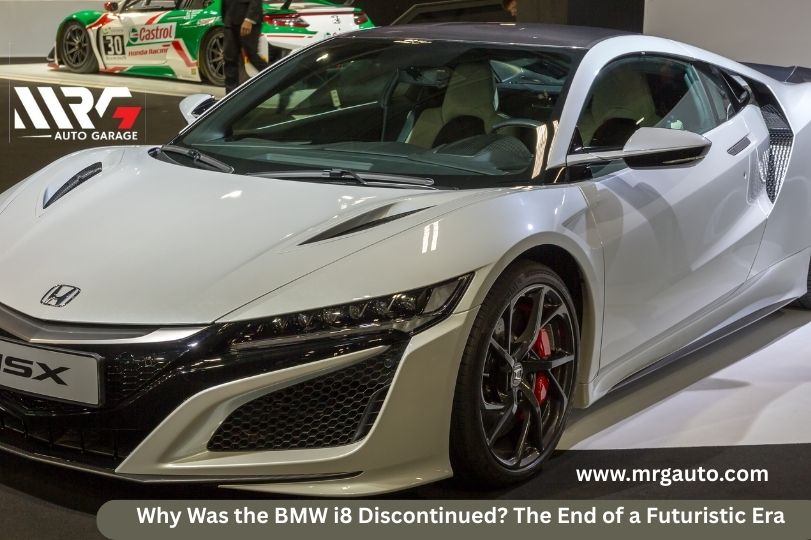The BMW i8 was more than just a car; it was a statement. With its butterfly doors, carbon-fiber body, and futuristic design, it looked like it had driven straight out of a sci-fi movie. So, when BMW decided to pull the plug, many fans were left asking: why was the BMW i8 discontinued?
The answer isn’t a single fault but a combination of shifting corporate strategy, technological evolution, and the car’s own niche positioning. If you’re wondering why did they stop making the BMW i8, this article explores the key factors that led to the end of this iconic hybrid sports car, including the timeline for when was the BMW i8 discontinued.
A Pioneer Ahead of Its Time
First, it’s important to acknowledge what the i8 was meant to be. Launched in 2014, it wasn’t designed to be the fastest supercar on the track. Instead, its mission was to showcase BMW’s “i” sub-brand and prove that high performance and sustainability could coexist. Its plug-in hybrid powertrain—a turbocharged 1.5-liter three-cylinder engine and an electric motor—combined for around 369 horsepower, enabling a 0-60 mph time of about 4.2 seconds with astonishing efficiency.
For a time, it had no direct competitors. But ultimately, the very factors that made it unique contributed to its demise.
The Top Reasons Why the BMW i8 Was Discontinued
1. The Shift to All-Electric: BMW’s New “i” Focus
This is the most significant reason why BMW i8 discontinued production. The i8 was a groundbreaking plug-in hybrid, but the entire automotive industry, including BMW, began pivoting aggressively toward fully electric vehicles (EVs) around the late 2010s.
BMW’s strategy for its “i” division evolved from showcasing hybrid technology to leading the charge in electromobility. Resources, research, and development budgets were redirected toward new, fully electric models like the iX3, i4, and iX. The i8, as a hybrid, no longer fit the new, forward-looking narrative. It was a pioneer of an interim technology that BMW was ready to move beyond.
2. High Cost and Complex Production
The i8 was an expensive car to build. Its core structure, the LifeDrive module, was made from carbon-fiber-reinforced plastic (CFRP), a lightweight but costly material. While this was essential for offsetting the weight of the batteries and achieving its performance, it made low-volume manufacturing complex and expensive.
As sales began to naturally decline after the initial hype, the business case for continuing such a specialized and costly production process became increasingly difficult to justify. The high price tag (often over $140,000) limited its market, and the costs couldn’t be scaled down effectively.
3. Performance Perception vs. The Competition
When the i8 launched, its performance was impressive. However, by the end of its lifecycle, the goalposts had moved. The rise of pure electric sports cars and hypercars, like the Tesla Model S Performance and the upcoming Audi e-tron GT, offered staggering, silent acceleration that the i8’s hybrid powertrain couldn’t match.
While the i8 offered a thrilling and balanced driving experience, some critics and consumers began to see its performance as less exceptional in a world where electric sedans could out-accelerate it. The conversation had shifted from “efficient performance” to “maximum electric performance,” a race the i8 wasn’t designed to win.
4. Niche Market and Limited Practicality
The i8 occupied a very specific niche. It was a low-slung, two-door coupe and roadster with limited storage space and two small rear seats best suited for luggage. This made it impractical as a daily driver for many. Its target audience was always small, and as the initial wow factor faded, sales inevitably slowed. BMW likely determined that future “halo cars” would be fully electric and could appeal to a broader performance audience.
When Was the BMW i8 Discontinued?
So, when was the BMW i8 discontinued? Production of the groundbreaking i8 officially ended in June 2020. The final unit was an i8 Roadster finished in Portimao Blue, which rolled off the production line in Leipzig, Germany.
The end of production was not abrupt. BMW had already ceased production of the i8 Coupe in April 2018 to focus on the newer i8 Roadster variant, which continued until the model’s final retirement in 2020. The decision to stop making the BMW i8 was likely made well before 2020, as the company’s electrification strategy solidified.
The Legacy of the BMW i8
Understanding why did they stop making the BMW i8 is not just about its shortcomings. It’s about recognizing its role as a technological testbed. The i8 proved that a sports car could be environmentally conscious without being boring. It pioneered the use of carbon fiber in high-volume production (for a niche model) and changed public perception of what a “green” car could be.
Its spirit lives on in BMW’s current and future EVs. The upcoming BMW i8 successor is widely expected to be a fully electric model, potentially based on the Vision M Next concept, which pays clear homage to the i8’s design. The i8’s job was to pave the way, and it succeeded brilliantly.
In summary, the question of why was the BMW i8 discontinued can be answered by looking at the bigger picture. It wasn’t because the car was a failure; on the contrary, it was a success in achieving its mission. It pushed boundaries, captured imaginations, and prepared the world for BMW’s electric future. It was discontinued because that future had arrived, and BMW’s resources were needed to build it. The i8’s retirement marks the end of a chapter, but its legacy as a revolutionary and iconic car is secure.

Aayush is an Automobile Engineer who repairs and tests cars and their components, applying engineering principles to improve the performance, safety, and efficiency. He works on car engines, brakes, and electrical systems, utilizing computerized models to predict performance and ensure vehicles meet standards.

